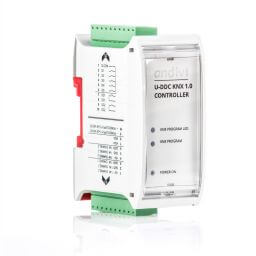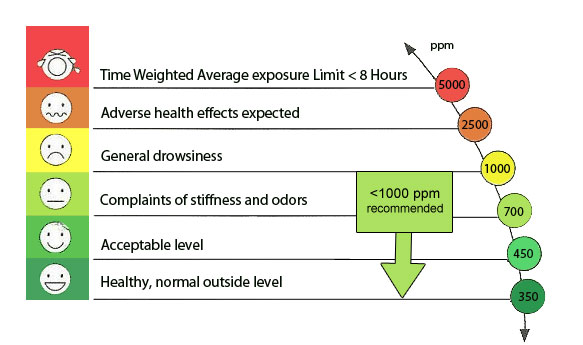Carbon dioxide – CO2 does not have a colour or any specific smell, the only way you can know the level of CO2 in your home for sure is through a Modbus CO2 sensor.
But when buying a Modbus CO2 sensor, choosing the right kind can be challenging. The main types of CO2 sensors on the market may be classified into three major categories depending on the measuring principle of sensors:
- Chemical CO2 sensors – with sensitive layers based on polymer- or heteropolysiloxane have the advantage of very low energy consumption and small size to fit into microelectronic-based systems. But on the other side, it is difficult to apply to a variety of practical fields because they have a short lifetime and as well as low durability and short and long term drift effects, these are major obstacles when compared with the NDIR measurement principle. When CO2 enters the sensor, it chemically reacts within the sensor. As this reaction occurs, the sensor experiences an electrical change. The sensor will then use the type and amount of electrical change to determine how much CO2 is present.
- MOS Sensors – for indoor environments like gyms, schools, or offices where the principal source of CO2 is human respiration, provides a good-enough estimator of the current CO2 concentration for ventilation and occupancy purposes. The reading they generate is called CO2 equivalent (CO2eq). Although the readings tend to be good enough in the long run, generated gases such as peeling fruits or using perfume can undermine their reliability. Very simple design makes them easy to use but this kind of sensors can be affected by temperature and humidity and other substances in the air that can throw off readings. MOS Sensors are usually used at higher, less common CO2 concentrations (>2000ppm).
- NDIR based CO2 sensor – NDIR or “nondispersive infrared” is the most common type of sensor used to measure carbon dioxide CO2. These sensors are commonly used in monitoring indoor air quality due to relatively high accuracy, very long-lasting, with some lasting more than ten years. They work well at common CO2 ranges (around 1000ppm) and other substances do not interfere with readings. The negative side is that can be affected by humidity and temperature.
Andivi Modbus CO2 sensors measure CO2 value via the NDIR sensor, which is able to compensate for possible pollution with the help of its 2-ray measuring principle. NDIR sensor detects CO2 in a gaseous environment by its characteristic absorption.
The key components are
- an infrared source,
- a light tube,
- an interference (wavelength) filter,
- an infrared detector.
CO2 NDIR sensor works in a way that air enters the sensor which activates a light set at one of the specific wavelengths for CO2. The other side holds a receptacle that measures how much light it to the other side. Once the light is activated, any CO2 in the air sample will absorb some of the beams. In doing so, the amount of light that makes it to the other side of the sensor decreases. At the detector end, the remaining light hits an optical filter that absorbs every wavelength of light except the wavelength absorbed by CO2 molecules in the air sample tube.
The electronics measure the absorption of the characteristic wavelength of light. The amount of light that gets absorbed depends on how much carbon dioxide is present. The more CO2 that is present, the more light that will be absorbed.
All measurements start out as analog micro-voltages. While some sensors output this as an analog voltage or 4-20mA signal, some also include an analog to digital converter on the sensor PCB that converts the voltages into RS-485 output. This kind of output is especially useful for using NDIR CO2 sensors on controllers like Andivi U-DDC controller.
Modbus protocol
Modbus is popular in industrial environments because it is openly published and can be used with almost every controller on the market. It uses the RS485 or Ethernet as its wiring type. Modbus is relatively easy to deploy and maintain compared to other standards. It was developed for industrial applications for communication to and from multiple devices connected to the same cable or Ethernet network – for example complex devices like heat pump, A/C unit, HVAC systems can be connected to Modbus controllers, and therefore there’s a connection between the systems and the sensors. Modbus is used to connect a system supervisory computer with a remote terminal unit (RTU) in Supervisory Control and Data Acquisition (SCADA) systems in the electric industry.
Andivi Modbus CO2 sensors
The Andivi Modbus sensors communicate over Modbus RTU – RS485 and they can be used as open system components with the majority of building control systems and controllers. There are two different Modbus CO2 sensors depending on the method of use:
- Indoor Modbus CO2 sensor ANDRACO2/MD – for indoor use like offices, school rooms, gyms. Modbus room sensor for carbon dioxide and temperature measurement ANDRACO2-MD reliably detects the CO2 concentration in the ambient air in rooms and offices. Within a range of 0-2000ppm or optionally 0-5000ppm, the ANDRACO2-MD converts the measured values into Modbus RS485 protocol.
- Duct Modbus CO2 sensor ANDKACO2/MD – Duct Modbus Co2 sensor records the CO2 concentration within the ventilation ducts and tubes of room technology systems. Within a range of 0-2000ppm or optionally from 0-5000ppm, and the values can be output via a Modbus connection.
Both CO2 sensors’ values are measured using an NDIR sensor that works on an infrared basis and compensates for any contamination with its 2-beam measuring principle. Sensors are optionally available with additional temperature and humidity measurements.
| ANDRACO2/MD | ANDKACO2/MD | |
| Protocol | Modbus (ASCII/RTU), RS485 | Modbus (ASCII/RTU), RS485 |
| Power supply | 12 … .34 VAC/VDC | 12 … .34 VAC/VDC |
| Measuring range CO2: | 0 … 2000 ppm / 0 … 5000 ppm | 0 … 2000 ppm / 0 … 5000 ppm |
| Protection class: | IP30 | IP65 |
| Sensor element: | (NDIR) sensor with automatic background calibration | (NDIR) sensor with automatic background calibration |
| More about sensor: | Indoor Modbus Co2 sensor | Duct Modbus Co2 sensor |
CO2 Sensor installation
Air quality is crucial for our wellbeing. Modbus CO2 Sensors and air quality sensors are one of the most sensitive sensors on the market and that is why we have to consider well about its mounting. It is not advisable to mount a CO2 sensor somewhere under the ceiling, as the measured gas content will be much lower than the real one. It must be mounted at a height of about 1.40 m, which is considered a standard in the construction of industrial facilities. In addition, air currents are also important because the air around us circulates all the time, even if we do not feel the wind. The airflow can be redirected by opening doors, windows, etc. from this we can conclude that the CO2 sensor must be installed in as neutral a place as possible. Only with that sensor installation will we get the most accurate CO2 gas measurements for optimal living and working conditions.
Choosing the right CO2 sensor for your building or HVAC system is crucial for maintaining air quality and well-being. To help you make an informed decision, we’ve compared two leading options: Siemens QPA and Andivi CO2 Sensors.
CO2 levels
CO2 Levels are measured as PPM (Parts per million) which is a unit for measuring the concentration of CO2 in the air. The standard outdoor level is around 350ppm, and is the optimum level for freshness. CO2 concentration is an important factor of good indoor air quality. People breathe in oxygen and breathe out CO2 so the Indoor concentration of CO2 is far higher than the outdoor average. Indoor places can generally get up to 600ppm without any adverse effects. Once it is over 600ppm people will start noticing adverse effects with an impact on productivity and wellbeing. With the high CO2 concentration and non- proper ventilation, people will feel headaches, dull, drowsiness, loss of concentration. Consequently, it is very important to measure and monitoring CO2 in our workplaces because the higher the levels of CO2 are the lower is the productivity and inversely the lower the levels are, the better one can work.
Here, you can learn more about The Importance Of Air Quality In Public Institutions
co2monitor.com.au
Please do not hesitate to contact us.










